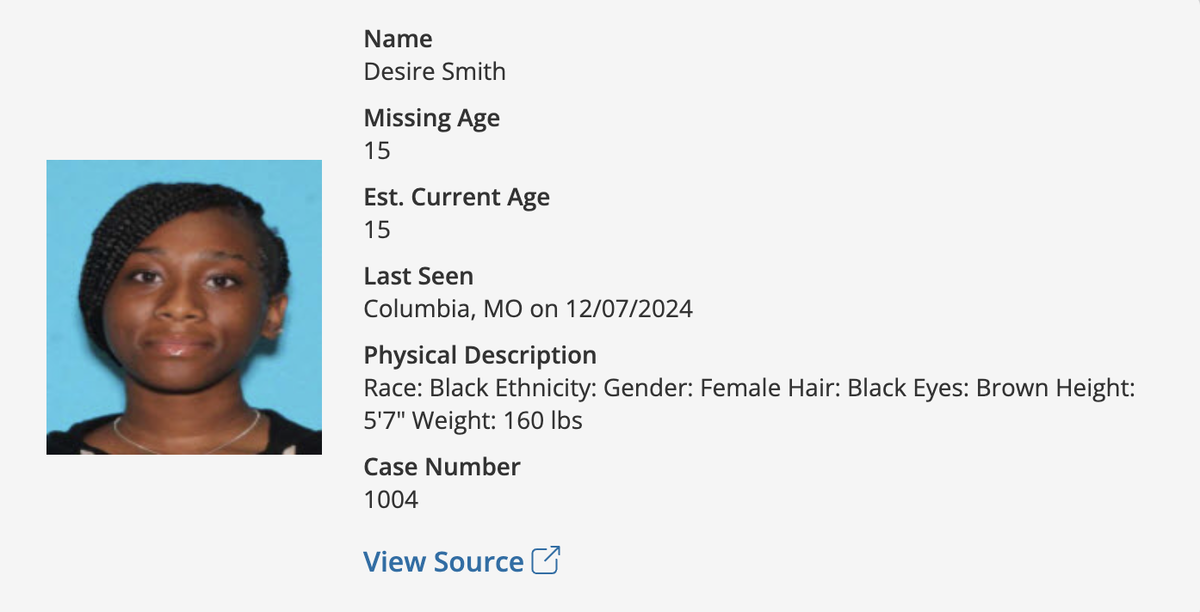Desire Smith missing nearly four months as Missouri confronts racial disparities of missing people

Mitchell Kaminski
EDITOR’S NOTE: An incorrect bill number has been removed from the story.
COLUMBIA, Mo. (KMIZ)
Black Missourians are reported missing at disproportionately higher rates than their share of the population, a troubling trend now affecting a Columbia family.
Desire Smith, 15, has been missing for nearly four months after she was last seen in Columbia on Dec. 7, 2024. She is 5-feet-7-inches tall, weighs about 160 pounds and has black hair and brown eyes.
Smith’s grandmother, Crystal Watson, is pleading for any information about the missing teen, after the family fears she ran away from home.
However, Watson says that growing up on Rice Road, a northeast Columbia neighborhood that has seen a high volume of shootings, may have had a negative influence on her.
“She’s a happy girl, she is really intelligent, got all the good qualities,” Watson said. “It’s just I feel like her living in this area also influences her different ways in her different attitudes in doing things.”
Smith’s family has also grown frustrated with the lack of attention the case has received.
“I feel like, maybe if she were white, you know, it would have been out there. She is on the child missing list, if you look it up in Columbia, she is on there, but it’s just not enough attention to it.”
 Desire Smith, 15, has been missing for nearly four months after she was last seen in Columbia on Dec. 7, 2024. [Courtesy Crystal Watson]
Desire Smith, 15, has been missing for nearly four months after she was last seen in Columbia on Dec. 7, 2024. [Courtesy Crystal Watson]
When it comes to missing people in Missouri, there’s a clear and troubling trend.
Out of 658 adults currently listed as missing by the Missouri State Highway Patrol, 199 are Black, making up 30.2% of all cases, even though Black Americans make up just 11% of the Show Me State’s population. Among the 250 missing women in Missouri, 79 are black, making up 31.6%.
This mirrors nationwide figures. According to FBI data, Black Americans are overrepresented among missing persons nationwide. While Black people make up about 14% of the U.S. population, they account for 37% of those listed as missing in the FBI’s National Crime Information Center. In contrast, white people, who make up about 75% of the U.S. population, represent 59% of missing persons reported.
Age and sex also show disparities. Younger individuals — particularly young women — are significantly more likely to be reported missing, according to the National Center for Missing and Exploited Children.
To combat this trend, the Missouri Legislature approved a bill that establishes a “Missing and Murdered African American Women and Girls Task Force.”
The bill’s sponsor, Sen. Angela Mosley (D-St. Louis County) says in the summer of 2023, she had an opportunity to connect with lawmakers from Minnesota, where a similar bill was passed.
“The task force will take a really hard look at why African-American women and girls are an endangered species, how our systems are falling short and what we can do to change that,” Mosley said. “We want to investigate the root causes of these disappearances and acts of violence, improve the way we collect data so these cases don’t fall through the cracks.”
Mosley added that the task force will also examine response times and how police and media respond to these incidents, while also developing solutions to “protect our loved ones.”
The task force will include about 10 members, made up of lawmakers and law enforcement officials appointed by the president pro tem of the Senate, the Senate minority floor leader, the speaker of the House, the House minority leader and the director of public safety.
Mosley said the task force is also seeking a survivor of gender-based violence and representatives from a statewide organization that provides advocacy and counseling for Black women and girls.
“Of course, you run those who asked that question, ‘Why focus on African-American women and girls?’ There are colleagues that have a background in law enforcement, and they saw the urgency of it and tried to help me speak with other colleagues to let them know that this is important because African-American women make up 11% of the population. However, 42% of the murders are of African-American women, girls. So that shows there is a huge issue in our state,” Mosley said.
Columbia Police Department records show that since 1998, 16 Black women have been killed in homicides, with more than half of those occurring within the past 10 years.
“We’re hoping that we get the data we need to make sure that this we get the numbers to start going down,” Moseley said. “Hopefully, one day we can get an office just like Minnesota.”